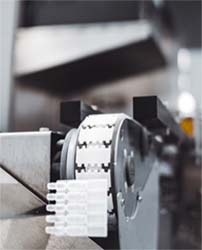Once a drug product is filled in a pharmaceutical-grade plastic container using Blow-Fill-Seal, that drug product may be further protected against external elements which may impact its effectiveness over time.
This is why filled BFS containers are typically enclosed in a foil-polymer overwrap.
Foil, as its commonly referred to, is actually a composite of polymers and aluminum foil sandwiched in a thin film. This film is hermetically sealed using pressure and heat.
Foil as secondary packaging serves two major functions to help protect the drug product during storage.
The first is to slow the gas and vapor permeation across pharmaceutical-grade plastic. Foil overwrapping creates a sealed, self-contained space around the BFS vials where environmental equilibrium is reached which helps to limit gas and vapor transmission from the BFS vials.
The second reason for foil overwrapping is to limit light or oxygen exposure. Once wrapped in the foil pouch light exposure is eliminated, and during the wrapping process the foil pouch may be filled with an inert gas overlay, such as nitrogen, to help prevent oxidation of the drug product.
There are many different types of foil. Based on the drug’s storage requirements, ApiJect can help your team choose the best foil.
